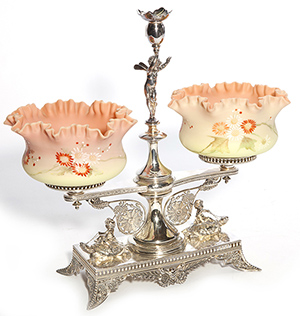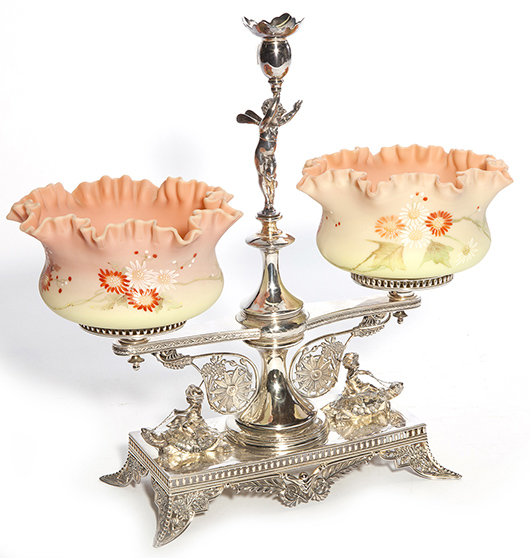
BEACHWOOD, Ohio – Is it called a fruit bowl, berry bowl, fruit stand, fruit dish, epergne, basket or bride’s basket? A search of 1880s and ’90s catalogs of silver and glass tableware manufacturers had similar pieces called by any one of these names.
A formal Victorian dinner party served multiple courses with special serving pieces for each one. The many-named stand was used at the end of the meal. A typical dinner had up to nine courses. First was raw oysters, then soup, meat, poultry, salad, dessert, then fruit and perhaps cheese, followed by coffee and tea in the drawing room. The table was cleared between courses and sometimes even fresh tablecloths were used.
The bowl with many names often was the centerpiece for the dessert and fruit courses. There were small berry bowls and berry sets that held strawberries or raspberries or similar fruit served with fresh cream and sugar. Elaborate stands that held colored glass bowls probably held fruit like bunches of grapes, or apples that are easier to serve since the bowl and stand would be too heavy to pass around the table. The silver-plated stands were decorated with three dimensional figures, animals, flowers or strange groupings like a cupid driving a chariot pulled by a peacock or the Greek god Poseidon with his spear poised to catch a piece of fruit from the bowl below. The bowls were sometimes silver but more often were colored art glass like Amberina, Burmese, Peachblow, Pomona, satin glass, or pressed or cut glass.
Because collectors since the 1960s have preferred colored glass, art glass pieces found in stands today often are replacements for the original old clear glass bowls. An all-original “berry bowl set” on a silver-plated stand with two Burmese bowls decorated with flowers sold recently. The silver stand featured young boys riding on turtles. It sold in 2014 at an Early’s Art Glass auction in Milford, Ohio, for $3,220.
Q: A family member has a coffee table and two end tables that are stumping us. The tables were purchased in Germany in the late 1950s or early 1960s. The tops are hand carved, stained and painted, and covered with a piece of glass that can be removed. The legs are screwed in. They are marked on the bottom “D.B.G.M. Geschutzt.” I hope you can help with some information and a value.
A: Your tables are in the style called “Black Forest,” a term used to describe the elaborate, naturalistic wood carvings of animals, plants and landscapes thought to be made in the Bavarian Black Forest region of southwest Germany. But most pieces were really made in Brienz, Switzerland, where the carving style started in the early 1800s. From the mid-1880s to the 1940s, Brienz wood carvers made rustic clocks, benches, hall trees, smoking stands, chairs, tables and other furniture they sold to tourists. It was popular with Americans. The mark on your tables stands for Deutsches Bundes Gebrauchsmuster (German Federal Registered Design) and was used in West Germany from 1948 to 1985. So your tables were probably made in the 1950s. Black Forest carvings from Brienz are from the 1880s to 1920s are sought after and sell for a lot of money. Most midcentury Black Forest style pieces made for tourists in Germany or Austria, are machine-made and worth much less. Your tables could sell for $50 to $100.
Q: Please tell me the value of a 1939 San Francisco World’s Fair woman’s compact. It has an image of a tall building on the front.
A: The Golden Gate International Exposition was held on Treasure Island in San Francisco Bay in 1939-40. Among the many souvenirs of the fair are several different styles of compacts. The building pictured on your compact is the Expo Tower at the fair’s main entrance. Any compact from the fair sells for about $10-$20.
Q: I have an antique doll that reads “Dainty Dorothy, Germany” on the tummy. It has yellow hair, a bisque head, open mouth with teeth, and a kid body. It is jointed but is missing a hand. It has shoes and socks and a new dress. The doll is about 21 inches tall. Can you tell me how old it is and what it might be worth?
A: Dainty Dorothy was a line of dolls sold by Sears, Roebuck & Co. and by T. Eaton Co., a Canadian department store, from 1910 until; at least 1922. Kestner, Simon & Halbig, Armand Marseille, and Gebruder Heubach made bisque heads for the dolls. If you find a manufacturer’s mark on the doll’s head on the back of the neck, you can identify the maker. Dolls with composition forearms and lower legs were made beginning in 1912. An all composition version was sold by Eaton in 1918. Not having the original dress doesn’t affect the value very much but the value of your doll is lower because it’s missing a hand. Your doll is worth $50 to $75.
Tip: Cover the nose of your hammer with a piece of felt to protect the wall when you are putting up picture hooks. If the wall is smooth, some of the new stick-on hooks might work.
Terry Kovel and Kim Kovel answer questions sent to the column. By sending a letter with a question, you give full permission for use in the column or any other Kovel forum. Names, addresses or email addresses will not be published. We cannot guarantee the return of photographs, but if a stamped envelope is included, we will try. The amount of mail makes personal answers or appraisals impossible. Write to Kovels, Auction Central News, King Features Syndicate, 300 W. 57th St., New York, NY 10019.
CURRENT PRICES
Current prices are recorded from antiques shows, flea markets, sales and auctions throughout the United States. Prices vary in different locations because of local economic conditions.
- Match safe, Odd Fellows, fraternal symbols, metal, Hendrick Hudson Hotel, Troy, N.Y., $120.
- Sign, Dontophile toothpaste, black man, showing off white teeth, tin, France, 18 1/2 x 7 1/2 inches, $150.
- Mahatma Gandhi figurine, seated, crossed legs, Royal Dux, 10 inches, $220.
- Coca-Cola postcard, woman, seated, large black hat, frame, 1910, 7 3/4 x 5 3/4 inches, $390.
- Sterling-silver flask, embossed, men drinking around table, R. Wallace & Sons, c. 1900, 5 1/4 inches, $470.
- Butler’s desk, Hepplewhite, cherry, mahogany banding, six drawers, c. 1810, 47 x 22 inches, $515.
- Toy car, Edsel, convertible, cream, light green, box reads “New Edsel,” “Child Land,” Haji trademark, Japan, box, 10 3/4 inches, $3,894.
- Contemporary glass basket, “Untitled No. 1,” green lip, mottled designs, signed D. Chihuly, 1988, 17 x 12 1/2 inches, $4,750.
- Walking stick, maple, patriotic relief-carved scenes, Zachariah Robinson, c. 1865, 35 inches, $4,890.
- Boneshaker bicycle, transitional high-wheel ordinary, bronze oiler cast pedals, rear brake, coaster pegs, c. 1870, $6,145.
New! “Kovels’ Antiques & Collectibles Price Guide, 2015,” 47th edition, is your most accurate source for current prices. It’s available this month and includes a special bonus section that helps you determine prices if you’re downsizing and selling your antiques. It’s the best book to own if you buy, sell or collect – and if you order now, you’ll receive a copy with the author’s autograph. This large-size paperback has more than 2,500 color photographs and more than 32,000 up-to-date prices for more than 700 categories of antiques and collectibles. You’ll also find hundreds of factory histories and marks, a report on the record prices of the year and helpful sidebars and tips about buying, selling, collecting and preserving your treasures. Available for $27.95 plus $4.95 postage. Purchase online at KovelsOnlineStore.com ; by phone at 800-303-1996; at your local bookstore; or write to Price Book, P.O. Box 22900, Beachwood, OH 44122.
© 2014 by Cowles Syndicate Inc. 
ADDITIONAL IMAGE OF NOTE


